Tradescantia Callisia: Growing “Pink Panther” Indoors
Tradescantia Callisia, better known by its nickname: the Pink Panther! This eye-catching trailing tropical plant is quickly becoming a staple in home gardens thanks to its neon colored foliage and super simple care needs.
As an experienced indoor gardener, I can’t get enough of these little pink beauties. Let me tell you why I think the Tradescantia Pink Panther totally stands out from other houseplants:
Bursting With Vibrant Color
The #1 thing you’ll notice about Tradescantia Callisia is its fabulously colored leaves! They showcase a vivid ombre effect, with each pointed leaf fading from a deep fuchsia pink at the base to a lighter pink towards the tip.
- The foliage also features delicate white and green stripes mixed throughout for added visual interest.
- These neon pink leaves clustered together in rosette shapes create a beautiful contrast against the plant’s arching burgundy stems.
- The color palette is so unique – this plant truly pops in any indoor space!
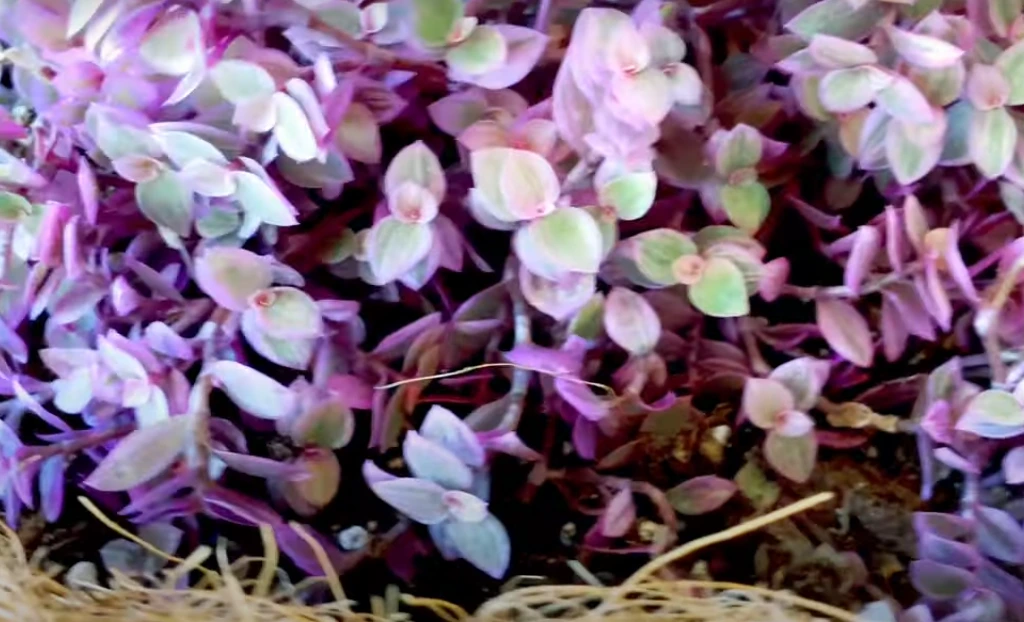
Trails Abundantly Like a Pink Waterfall
Another fantastic quality of the Pink Panther plant is its trailing growth habit. As the plant matures, the tinted stems rapidly lengthen while new leaves continuously sprout along them.
- After some time, your Tradescantia Callisia will transform into a waterfall of glorious pink foliage cascading beautifully in every direction!
Thrives With Minimal Care
For all its ornamental beauty and impact, the Tradescantia Pink Panther remains an easy going, low maintenance houseplant! This adaptable tropical plant has simple needs when grown as an indoor specimen.
- It thrives in average room temperatures and moderate humidity levels. No fancy equipment needed!
- While the Pink Panther enjoys bright filtered light, it tolerates shadier corners too – just may lose some color.
- These trailing plants also withstand occasional neglect if you forget to water! Though thorough weekly watering is best.
- And they essentially feed themselves from rich potting soil. Fertilizer is merely an occasional boost.
Easy Propagation for Endless Plants
One of the very best aspects of growing the Tradescantia Pink Panther is how effortlessly they propagate! You can create tons more plants from stem cuttings.
- Just clip a section of vine, strip most leaves, and place it in a vase of water until fresh roots emerge.
- Within weeks, plant the newly rooted cutting into fresh potting mix and voila – new baby plant!
- Through this simple propagation method, you can multiply single Pink Panthers into an endless trailing display anywhere.
In this article we’ll be looking at how you can grow Tradescantia Callisia “Pink Panther” Indoors successfully.
How to Grow Tradescantia Callisa (Pink Panther)
Caring for the vibrant Tradescantia Callisa really is a breeze – I promise it’s WAY easier than trying to grow orchids or other finicky flowers indoors. But there are still a few important pointers to follow in order to help your Pink Panther houseplant thrive.
Here’s everything you need to know about meeting the needs of this beauty…
Lighting Needs: Bright and Indirect Sunlight Please!
When it comes to lighting conditions, the Tradescantia Pink Panther plant isn’t too picky which makes it great for indoor life. This tropical plant originally hails from shady forest floors in Mexico and Guatemala. So it doesn’t demand tons of harsh sunlight like cacti or succulents.
But that doesn’t mean it wants to languish in dark corners either! Tradescantia Callisa plants definitely need a good amount of bright, vibrant light in order to retain their fabulous fuchsia colors and encourage lush leaf growth.
My recommendation is at least 4-6 hours of bright filtered sunlight daily. A spot near an east, west or lightly shaded south window is perfect. Just be sure to shield the plant from intense afternoon sun beating directly through the glass. The leaves can scorch if sunlight is too strong and direct.
You’ll know your Pink Panther plant is getting adequate light if the leaves maintain a neon pink, hot magenta and purple ombre colors. If the foliage starts fading to green or gets leggy/sparse, it needs a sunnier spot stat!

Prep the Perfect Potting Mix
Now let’s talk soil and containers to plant your trailing beauty in. Choosing the right vessel and potting medium sets up your Tradescantia Callisa for success from day one.
This tropical plant naturally grows in loose, fast-draining soil that’s rich in organic matter back in its jungle home. The roots dislike sitting wet for long. So I recommend using an extra airy, loose potting mix amended with things like peat moss, bark chips, perlite etc.
You can either make your own blend or purchase a commercial cacti/succulent mix. Just be sure whatever soil medium you use drains rapidly after watering. Stagnant moisture is the enemy of Pink Panther plant roots!
And because this plant cascades so beautifully, I highly suggest planting it in a hanging basket or decorative standing planter. The trailing stems will spill over the edges like a pink waterfall!
Terracotta pots work wonderfully as well – the natural clay helps pull excess moisture away from roots. Just be sure whatever container you choose has several drainage holes at the base.
Water Well Then Let Soil Dry Out
Figuring out the ideal watering routine for houseplants can be tricky business! But Understanding the Tradescantia Pink Panther’s needs makes it much easier.
As I mentioned earlier,
and overall health of this plant. Waterlogging causes fungal issues like root rot and wilty foliage. So we want to avoid that!
On the flip side, allowing the soil to completely dry out for too long can also stress the plant. So consistent moisture is key!
Here is my simple rule of thumb for watering Pink Panther plants:
Water your plant thoroughly whenever the top 50% of soil becomes dry to the touch. During hot summer months, this may mean watering 2-3 times per week. In cooler winter conditions, you may only need to water every 7-10 days.
Always check with your finger before adding more water! And whenever you do irrigate, water slowly and deeply until it drains freely from the bottom. This encourages stronger roots to form.
It’s also a great idea to add pebbles or stones in the drainage tray under your pot. This keeps the plant elevated above any water that accumulates after watering. Perfect drainage!
Feed Occasionally For Colorful Leaves
When it comes to fertilizer for the Tradescantia Pink Panther, less is often more! I only feed mine 2-3 times during the active growing season from spring through summer. This encourages lush foliage without pushing soft rapid growth.
The best fertilizer for Pink Panther plants is actually a diluted balanced liquid plant food. Look for equal or near equal ratios of Nitrogen(N), Phosphorous(P) and Potassium(K) on the label. I use an all-purpose 10-10-10 formula diluted to 1/4 strength.
Another option is to use organic fish emulsion or compost tea once a month or so. The nutrients in these organic options break down slower, so they provide a steady feeding.
In the fall and winter, you can totally stop fertilizing altogether. Plants take a natural rest during colder months. Feeding during dormancy can sometimes do more harm than good!
Ideal Temps and Humidity Levels
As you likely know already, the Tradescantia Pink Panther plant hails from steamy tropical forests. So to keep your houseplant happy and thriving during indoor life, we need to consider temperature and humidity factors.
Let’s start with ideal temps for this trailing beauty. In general, comfortable room temperatures between 60-80°F are perfectly fine for the Pink Panther. This plant dislikes frosty cold drafts. So keep it away from freezing windows and AC vents during winter!
If your home gets warmer than 80°F, not to worry. As long as you have good airflow and humidity, this tropical plant can withstand heat. Just watch for wilting, which signals distress.
Speaking of humidity – the Tradescantia Callisa enjoys moderately muggy conditions. But it’s adaptable to our dry indoor living spaces too. To boost moisture levels around your plant, use a pebble tray, install a room humidifier, or simply mist the leaves several times per week.
Time to Transplant? Tips for Repotting Pink Panthers
Typically you’ll need to repot container plants every couple years in order to “refresh” root zone soil that’s depleted of nutrients. This is definitely true of the fast growing Tradescantia Pink Panther!
Here are my best tips for successfully transplanting your plant into a larger container without shocking the roots:
- Carefully slide the plant from its old pot and loosen tightly wound roots on the root ball. This encourages new growth outward into the new container.
- Prune off any dead or damaged roots. Healthy roots will be firm and white.
- Choose a new container that’s 2-4 inches wider than the current pot. Make sure it has drainage holes at base and complements your plant’s trailing shape.
- Use fresh, sterile indoor potting soil (like my soil blend recommendation above). Old caked soil doesn’t have nutrients left.
- Handle the plant gently! Position the root ball in the new container so top of roots sit 1 inch below the soil line. Fill gaps with soil.
- After repotting, give the plant several weeks to recover before fertilizing. And resume normal care routine.
Follow these tips and your Pink Panther will quickly bounce back better than ever! You may get increased flowering and trailing length too.
Propagating this Plant is Simple & Fun!
It wouldn’t be enough to talk about successfully growing the Tradescantia Pink Panther without mentioning how incredibly EASY it is to get new plants.
Propagating Pink Panthers requires just a few steps:
- Carefully clip off a stem around 6 inches long using clean shears. Choose a section with several leaf node joints.
- Strip off lower 2-3 sets of leaves to expose the stem nodes. These are where fresh roots will emerge!
- Place the freshly cut end into a vase or jar filled with clean water. I like to gently stir the water to increase oxygen.
- Situate your cutting vessel in a bright spot out of direct sun. Refresh water weekly.
Within just 7-10 days, vigorous fresh slimy white roots will being trailing from the submerged stem nodes into the water. Once a complex web of anchoring roots have formed, you’re ready to pot up your new plant baby!
Follow my soil blend recommendations in a container with drainage holes. Keep evenly moist and your new propagation will establish in no time. With this easy method, you can make endless Pink Panther plant!
That just wraps up everything you need to know to successfully grow wonderful Tradescantia Callisa houseplants like a pro!
Caring for Your Tradescantia Callisa (Pink Panther)
You planted your Tradescantia Pink Panther and now have your very own colorful trailing houseplant! Give yourself a pat on the back. But our green thumb journey isn’t over yet – there’s still some important caretaking our tropical friend needs from us on a regular basis.
Caring for the Pink Panther plant really doesn’t take too much effort at all. And the rewards of watching those fuschia leaves multiply is so worth it! But to help your new plant thieve happily for years to come, be sure tend to these key needs:
Proper Pruning Promotes More Flowers & Trailing
To keep your Tradescantia Callisa full and vibrant indoors, you definitely need to give it some periodic haircuts! Pruning serves some really important functions:
1) Encourages fuller, bushier growth
Like many trailing houseplants, the Pink Panther tends to devote energy to new stem length rather than chick leaves along the length. By giving it a trim, you force more small offshoots to grow from nodes and fill it out.
2) Prevents leggy, tangled appearance
Without occasional pruning, long vines trail everywhere and get unruly fast. Trimming back forces compact shape.
3) Can boost flowering
Snipping stem tips triggers a chemical response in plants. More pruning often means more flowers trying to regrow!
4) Makes propagation materials
Those cuttings are perfect for rooting in water to make more plants!
When and how often to prune your Tradescantia Pink Panther depends on its size, growth rate and your personal shaping preferences. But generally, pruning every 2-3 months works beautifully.
Step-By-Step Guide to Pruning Pink Panther Plants
Here’s a simple walkthrough for giving your plant the perfect haircut:
1. Sterilize Bypass Hand Pruners
Dip the blades in rubbing alcohol. Clean tools prevent spreading diseases between plants via open cuts.
2. Remove Dead or Dying Foliage
First get rid of any fully dried, dead leaves. Healthy pruning removes weaker parts first.
3. Identify Newest “Tip Growth” Areas
This is the new tender stem and leaves at very ends. Don’t remove this newer growth!
4. Trim back Overlong Trailing Stems
Clip back extra long vines trailing on floor or furniture. Leave newer tips!
5. Shape More Compact Growth Habit
For bushiness, prune back 1/3 to 1/2 of total stem length all over.
And that’s the basics of keeping your Tradescantia Callisapruned for optimal health and shaping. Follow these tips and you’ll have the most fabulous full hanging basket of fuchsia in no time!
Prevent Pest Problems Before They Take Hold
One of the very best parts of growing the versatile Tradescantia Pink Panther is that it’s mostly pest and disease resistant! This tough tropical plant has adapted natural defenses against infections and creepy crawly insects over millions of years. So it holds up wonderfully to indoor living.
But occasionally issues can still arise if conditions aren’t ideal. Here’s how to prevent potential problems:
Site houseplants in rooms with good airflow – Stagnant stale air increases likelihood of pests. Open doors and windows when possible.
Allow soil to dry adequately between waterings – Fungus gnats and root issues develop in perpetually soggy soil. Don’t overwater!
Quarantine new plants before introducing to others – Inspect for insects hiding in leaves or soil that could spread to existing plants nearby.
Treat immediately at any sign of infestation – Catch issues early before they get out of hand! Sticky traps, neem oil and insecticidal soap work great.
Discard severely infected plants – Sometimes pests like spider mites take over so fully that the plant can’t be saved. Toss it before they spread!
Follow these handy proactive tips and you shouldn’t have too many problems with your Pink Panther plants! Their tropical nature makes them naturally resilient to bugs and disease.
Root Rot Begone! Water Only When Soil Dries
Earlier when talking about watering needs, I mentioned how poor drainage and overwatering is the demise of many fabulous Tradescantia Pink Panthers. Root rot is a real downer!
That’s why it’s critical to always make sure excess liquid flows freely from bottom drainage holes after watering. And only add more when the top several inches of soil become totally dry to the touch.
You can easily monitor moisture levels using your finger or a thin wooden skewer. Push it an inch or two down – if it feels cool and damp still, hold off watering!
Potted plants should be checked 1-2 times weekly for dryness. Hanging baskets and wall planters often need water a bit more frequently. Get to know your plant’s rhythm!
Letting the Pink Panther dry out moderately between drink encourages stronger, more extensive root systems to form. And prevents catastrophic root issues down the road. Healthy roots equal a healthy plant!
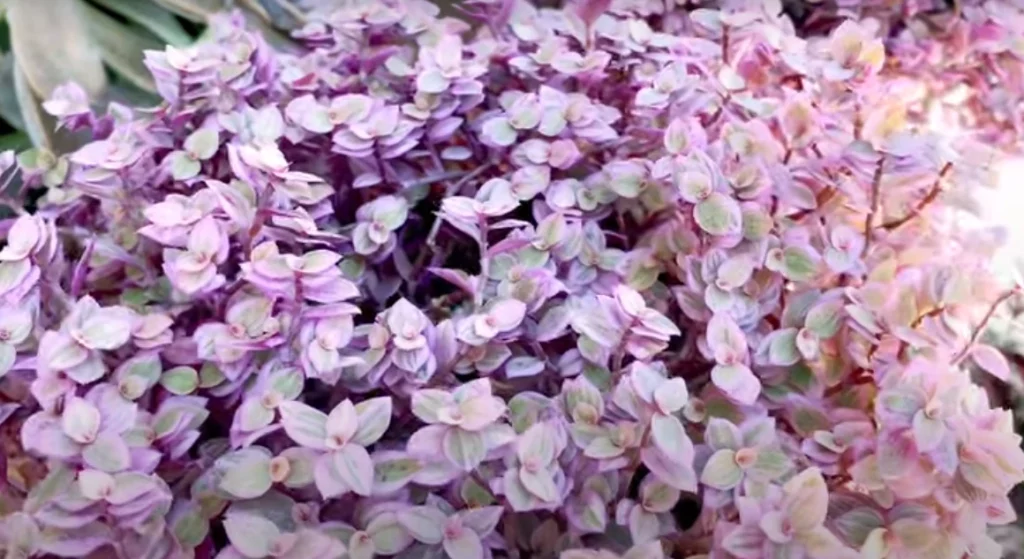
Boost Humidity Levels with Pebble Trays
The vibrant Tradescantia Pink Panther thrives in average indoor humidity, but providing slightly higher moisture does help its tropical leaves stay perky.
Some homes get downright parched during winter months when heat blasts nonstop. This warmer dry air dehydrates leaf tips, causing brown crispy appearance.
Luckily there’s an easy fix! Simply placing shallow pebble trays under your Pink Panther pots effectively increases humidity right around the plant’s foliage.
Just fill tray 2/3 full with pea gravel stones. Pour water into tray till just below stones. Place plant pot atop the stones – water shouldn’t touch base of pot. The evaporating water from tray will provide a humid microclimate!
Refill pebble trays whenever the water fully evaporates, or 1-2 times weekly. This system provides the humidity boost Tradescantia Pink Panthers adore without risk of overwatering. Give it a try!
Frequently Asked Questions About the Tradescantia Callisa (Pink Panther)
Well howdy friends! After our long chat about successfully growing the sensational Tradescantia Pink Panther indoors, you probably still have some nagging questions bouncing around. I got you! Here’s answers to some of the most common FAQs I receive about this awesome houseplant:
What causes Pink Panther leaves to turn green?
There’s really only one main reason you’ll notice your vibrant pink foliage fading to plain green – inadequate sunlight. These tropical plants need at least 4 hours of bright filtered light daily to maintain coloration. Move it to a brighter indoor spot!
Why are my plant’s leaves curling or wrinkling?
Curled, wrinkly looking leaves that are paler than normal indicate underwatering. The foliage shrivels without enough moisture reaching the roots. Check the soil and water your plant thoroughly if top several inches become totally dry.
Should I mist my Tradescantia Pink Panther?
Misting is not strictly necessary for these tropicals, but it can benefit them! Spritzing the leaves and soil surface 1-2 times per week adds supplemental humidity, which helps the foliage stay perky. Just don’t saturate the potting mix to avoid possible root issues.
What’s the ideal fertilizer schedule?
I recommend feeding indoor Pink Panthers monthly during spring and summer with diluted balanced liquid fertilizer. Stop fertilizing over winter when plants are dormant. And never fertilize stressed plants – it can damage roots!
Why are my plant’s leaf tips turning brown?
If you notice crispy brown edges developing on the foliage, the most likely cause is low humidity from hot forced air heating or A/C systems. Try using pebble trays for added moisture, mist more often or run a humidifier nearby.
Should I trim back leggy Pink Panther vines?
Absolutely! Judicious pruning not only keeps your plant from appearing overgrown and messy, but also encourages bushier new growth and possibly more flowers! Trim wandering leggy stems back by at least 1/3 their length.
What are those tiny black dots on the leaves?
Don’t panic just yet! Small specks on foliage could be fairy safe soil debris that splashed up during watering. BUT if they begin increasing rapidly or you see fine webbing, suspect spider mites. Take action immediately by spraying neem oil if pests are confirmed. Catch infestations early!
Why is my Pink Panther losing lower leaves suddenly?
Shedding older leaves along the bare stem is totally normal as plants mature from the top down. But rapid leaf drop from lower foliage usually indicates overwatering. Check for root rot and amend your watering routine to avoid saturated soil!
In Conclusion…
We’ve covered everything A to Z about successfully growing vibrant Tradescantia Callisa indoors. I hope you feel totally prepped to add one of these super easy and colorful trailing plants to your home habitat!
From lighting and soil needs to propagation, troubleshooting, styling tips and more – you have all the tools to watch your new Pink Panther houseplant thrive for years on end. These carefree tropicals are SO rewarding to nurture.
You may also be interested in these other Tradescantia articles:

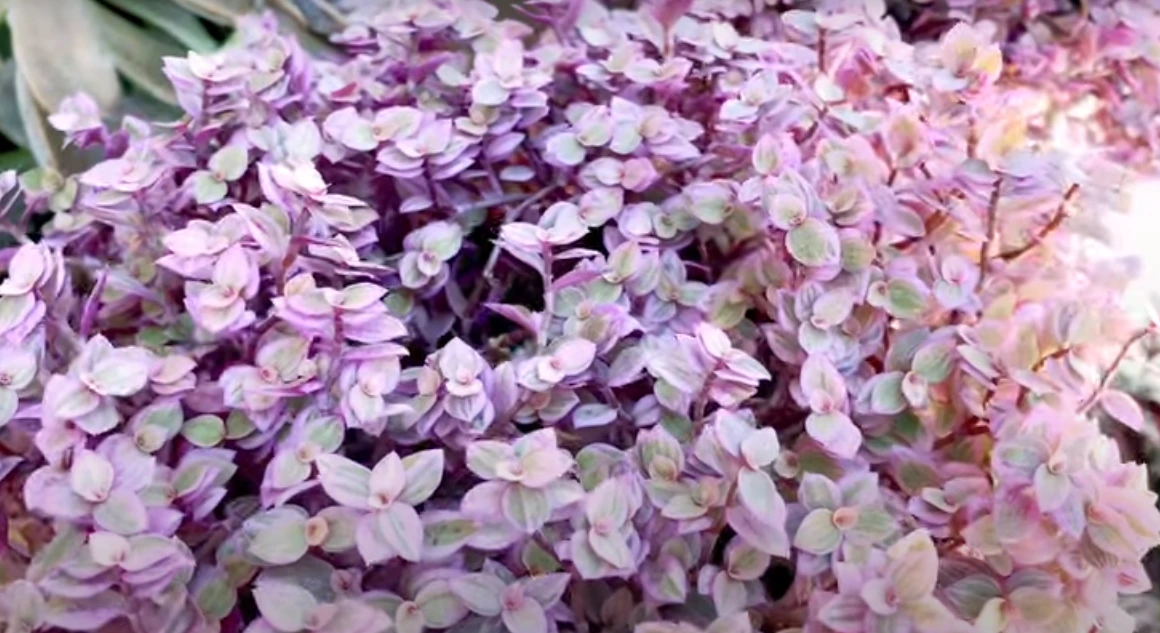

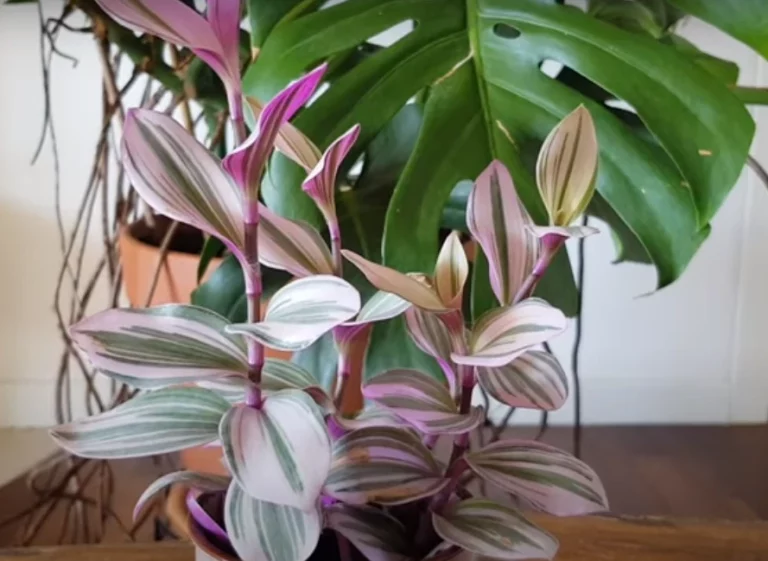
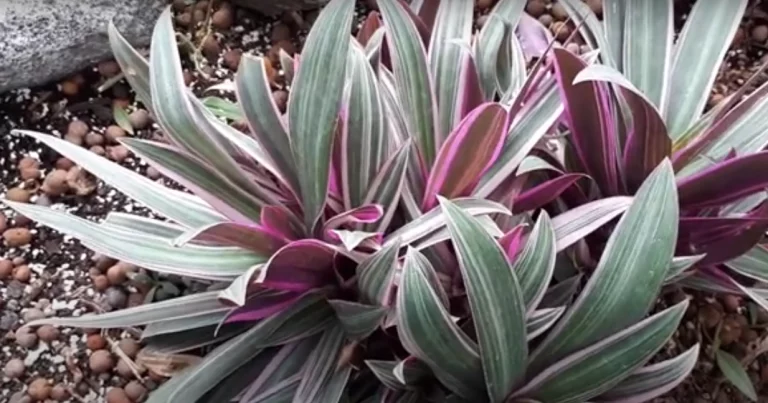
One Comment